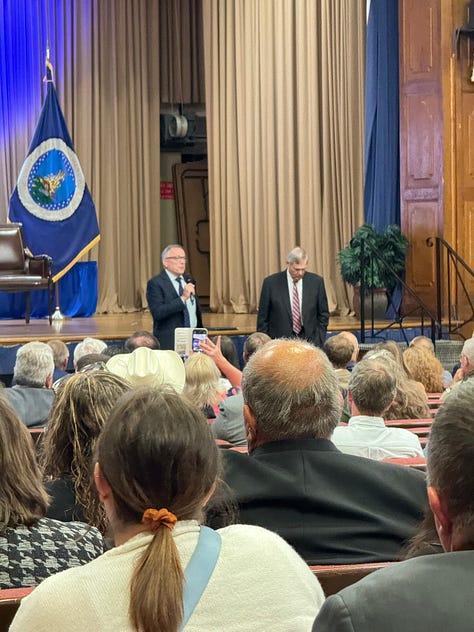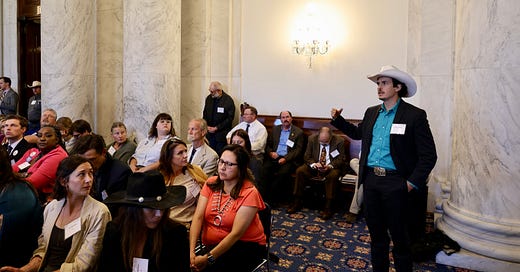Last week, I talked about the power of everyday folks coming together to fight the monopolists, such as how a bunch of Lampasas farmers sparked a national movement in 1877 (only two miles away from where I ranch) and how that spirit lives on today.
This week, I want to continue the conversation by talking about my recent trip to Washington DC with the National Farmers Union (NFU) to fight the robber barons of our age — Big Ag and the other monopolists.
But first, in honor of today being the first day of Hispanic Heritage Month, I want to talk about the documentary I saw in the plane that set the tone for the trip.
While on the plane from Texas to DC, I saw they had an inflight documentary about Delores Huerta. I knew a little bit about Delores, but coming from the Texas education system that purposely refuses to include her in their curriculum, I didn’t know much.
Learning about Delores and her role in creating the United Farm Workers union (UFW) caused me to go down the rabbit hole of the history of the UFW in Texas.
There was a Texas Farm Workers Union (TFWU) for a brief stint. It was founded by Antonio Orendain in 1975 after alleged disagreements between Orendain, who wanted to focus his efforts in Texas, and the national UFW, who were focusing on California and the other areas at the time. TFWU was mostly active in the Rio Grande Valley and a bit in West Texas.
TFWU, despite facing many challenges, did manage to raise wages for some farm workers, such as forcing melon growers in Presidio to more than doubled wages from 60 cents to $1.25 an hour. They also got a few bills into the Texas House, about establishing a Texas Agricultural Board that would give farm workers a seat at the table, though the bills ultimately did not pass. They marched from San Juan to Austin, then from Austin to Washington DC. Despite the media coverage, Carter refused to meet with them. TFWU as an organization came to an end sometime in the early to mid 1980s.
While there are different perspectives about why there was friction between the TFWU and the national organization, I do know that eating our own is the easiest way to be defeated. That’s a problem I’ve commonly witnessed in many progressive movements, both modern and past. We either succeed together or fail together, especially when we’re going against the monopolists with all the resources at their disposal.
Which is why I’m liking the work of the National Farmers Union, who I had the honor of representing the Texas Farmers Union at their annual Legislative Fly-In. We flew out to Washington DC to urge Congress to pass a good Farm Bill, which they are a year late in doing. More on the Farm Bill in a later post.



We met with U.S. Secretary of Agriculture Tom Vilsack. Sec. Vilsack talked a lot about the state of U.S. agriculture, including how there are essentially three types of operations:
Commercial: $350,000+ in sales per year. 10% of the U.S. farm population, or about 180,000 farmers. These are our biggest producers and our biggest food exporters. 60% of crop insurance goes to these folks. On average, they make about 20 cents per food dollar (so for every $1 you spend on food at the grocery store, they get about 20 cents).
Intermediary: Less than $350,000 in sales per year. This group has about 800,000 farmers, mostly family based. Most of these operations have to have an off-farm income to make it (or as I call it, a day job to pay for a day job). This group is often the bedrock of the local community, and they disportlortally send their kids to the military. On average, they make about 50 cents per food dollar.
Residential: Basically these are folks who have a home in a rural area and have some livestock or gardens on their property. This group is becoming more and more common as land in Texas is being bought and subdivided into ranchettes.
These three groups comprise the national farm economy, which represents about $116 billion net cash income. 80-85% of this income goes to the commercial producers, which is approximately $98 billion or about $500,000 per commercial farmer. About 15-20% of the income goes to the intermediary group, or about $10,000 per farmer.
The Farmers Union has both commercial and intermediary farmers in their ranks. While my heart is with the intermediary group as that’s where my family falls (I admittedly have a day job to have a day job), we, including Sec. Vilsack, recognize the commercial farmers have an important role. Their scale and efficiency helps keep food prices down and they are natural exporters — we are the breadbasket of the world, which will become only more true as climate change lowers food productivity in other parts of the world. More on that in a future article.
Many of these commercial farmers are also struggling, especially those who are still technically family farms. Corporations and monopolies, or as many call it the tyranny of the middlemen, are squeezing many of these folks dry. There’s a reason they only get 20 cents per food dollar. I met several commercial farmers who say their farms are not penciling out (translation: the corporate middlemen and monopolists are slowly running them out of business).
But we cannot put all of our eggs in a single basket. A food system monopolized by a single type of operation is a fragile system. For instance, one of the TFU families who joined the Texas Branch were a pair of dairy farmers in the Waco area. They were telling the story about how the Texas Freeze of 2021 disrupted the mega milk producers from delivering milk to the Waco area as their delivery trucks were too big to safely make the trip. Their farm was able to step in with their smaller trucks and supplied the good folks of the Waco area with dairy.
The intermediary farmers and lower-level commercial farmers are the balancers, the check on power, and the redundancy needed to make our food system secure.
As I told one of the Congress critters we met with, food security is national security, and one of the biggest threats to our food security are the corporate monopolists who are slowly but surely taking over our food system.
Or at least they were, as the tides are starting to shift. More on that in my next article. Tune in next week to learn more.





